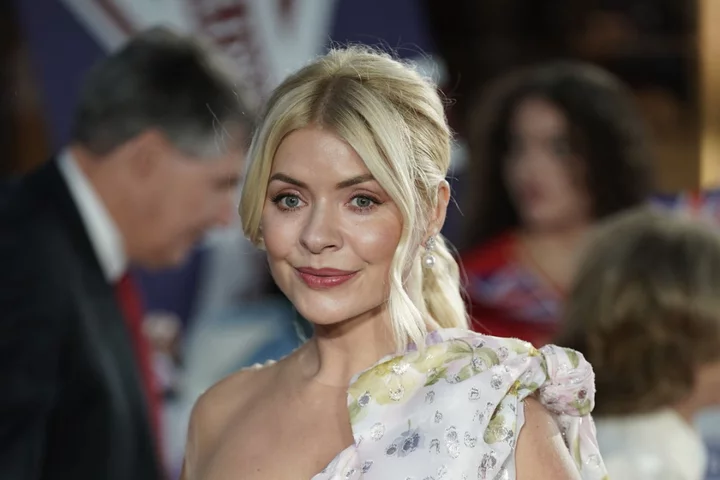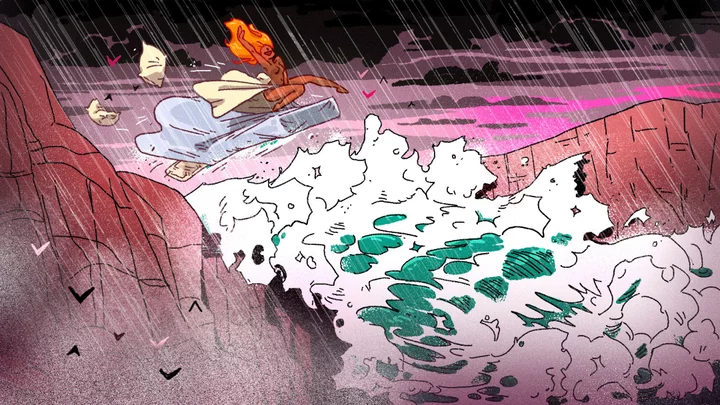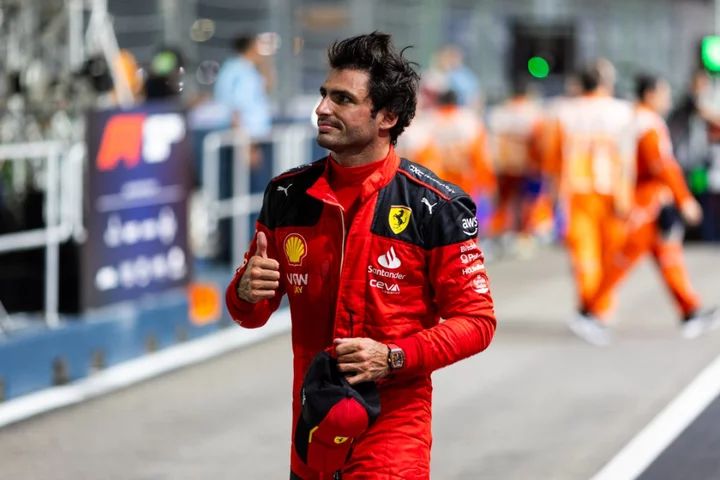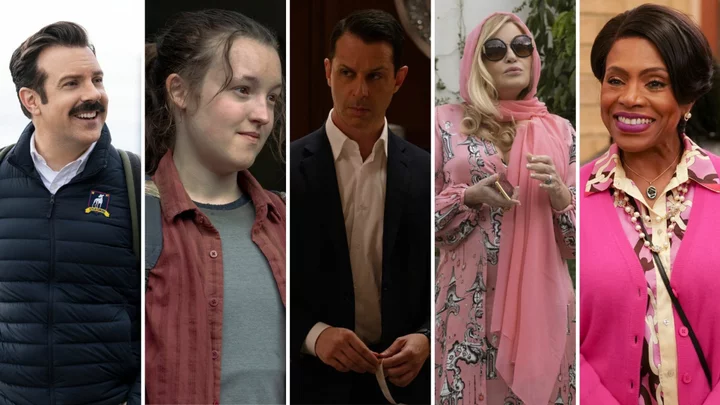She spent years traumatising us on Succession via the medium of never-ending family misery, and now Sarah Snook is back to mess with our heads in a new — albeit sort of connected — way.
Directed by Shining Girls' Daina Reid with the debut feature script from Burial Rites author Hannah Kent, Netflix's psychological horror-thriller Run Rabbit Run is, on the surface, about a fertility doctor struggling to deal with her seven-year-old daughter acting in increasingly strange ways. But it goes deeper than that, exploring themes of repressed childhood trauma and the ways this can manifest in the present, all while keeping us on our toes with several mysteries and a big twist at the end.
SEE ALSO: Scream time: 20 best horror movies on NetflixSo how does Run Rabbit Run end, and what does it all mean? Let's unpack.
What's Run Rabbit Run about?
Living in the Australian seaside town of Torquay, Victoria, Sarah (Snook) is a single mother grieving her father's death while trying to cope with the increasingly odd behaviour of her young daughter Mia (Lily LaTorre). It's pretty clear that Sarah is troubled from the outset, as she dodges calls from the nursing home where her mother Joan (Greta Scacchi) lives, diagnosed with the onset of dementia, and Sarah snaps at Mia's step-brother over an incident at a party.
Mia, meanwhile, doesn't help her mom's mood. Even though she's never met Sarah's estranged mother, she wants to know more about her grandmother and insists they visit, saying somewhat ominously, "I miss people I've never met all the time." On meeting Mia, Joan instead calls her granddaughter "Alice". We eventually find out this is the name of her daughter, Sarah's sister, who went missing in their childhood. Mia insists on being called Alice from then on, and she takes things way further than that, essentially "haunting" her mother for most of the film.
Sarah is haunted by her own daughter (played by Lily LaTorre). Credit: Sarah Enticknap/NetflixIs Mia the reincarnated version of Sarah's vanished sister, like she seems to believe? And what happened to Alice, anyway? The ending gives us some answers, but leaves others up to interpretation.
How does Run Rabbit Run end?
After taking Mia to stay at the house where Sarah grew up — an old clifftop bungalow in the rural South Australian town of Waikerie — her daughter's behaviour only gets stranger. Soon Mia is demanding to stay in Alice's old room, unchanged since her disappearance. She's wearing Alice’s clothes, creepily following her mother around the house, and falling victim to mysterious head injuries that seem to come out of nowhere. Meanwhile Sarah's mental health is worse than ever, to the point where she's even seeing her daughter in the visage of her missing sister.
In one of the film's most significant moments, Sarah has a vision of opening a locked cupboard in her childhood home's outbuilding only for Alice to burst out and attack her, strangling her while screaming, "You locked me in!" Sarah panics and hits Alice over the head with a rabbit trap, then chases her to the cliff edge. When Alice turns, Sarah sees the extent of her sister's injuries: she's bruised and bleeding from the nose, eye, and head (mirroring the injuries we've seen Mia sporting). Panicking and horrified at what she's done, Sarah pushes Alice over the edge.
Featured Video For You These are the best horror films on Netflix right nowLater, Sarah wakes from a trance-like state to the sound of her ex-husband Pete (Damon Herriman) banging on the door, worried after she hasn't answered his calls. Mia is nowhere to be found. The two of them go looking, searching the river at the base of the pivotal cliffs, where Sarah has another monstrous vision. Eventually, they find their daughter hiding outside the house in some bushes, but are being watched by a ghostly vision of Alice. That night, Mia/Alice gets her mother to admit she's a "monster", and in the morning she's not in her bed. Sarah looks out of the window and sees her daughter walking towards the cliffs, hand-in-hand with her dead sister.
What really happened to Sarah's sister, Alice?
For years, everybody thought Alice went missing. Joan still believes her daughter will come back one day, but the fact she vanished when she was playing with Sarah has clearly caused their relationship to deteriorate. The truth, which Sarah has been hiding away since she was a little girl, is exactly what we see in the aforementioned vision: Sarah locked her sister Alice in a cupboard during a game of hide-and-seek, then hit her over the head harder than she meant to during their ensuing fight. When Sarah realised what she'd done and feared punishment, she pushed Alice over the cliff into the depths of the Murray River below, where her sister's body has presumably been ever since. She killed her sister, then buried the memory of it.
"Mia acts as a catalyst for the emerging, unstoppable trauma of Sarah’s past resurfacing." Credit: Sarah Enticknap/NetflixClearly, though, Sarah can't run from her actions forever. When we meet her at the beginning of the film, the recent death of her father coupled with her own daughter turning seven — the same age Alice was when she died — clearly causes these memories to surface. In the film, Mia essentially becomes a conduit for Sarah's repressed guilt and trauma, and director Reid confirms this in the production notes, writing, "The increasingly strange behaviour of her young daughter Mia acts as a catalyst for the emerging, unstoppable trauma of Sarah’s past resurfacing."
Mia's consciousness as herself and as Alice starts to blur as the film progresses. "No, I don't like hide-and-seek," Mia yells at her mother at one point in the film, after asking what games Alice liked to play when they were younger. "You don't look for me. You don't like me," she says. "You make me hide, and hide, and hide — you make me hide all day. You don't want to find me. You lock me in."
What's the significance of the white rabbit in Run Rabbit Run?
"I think rabbits are always hugely creepy in films," writer Kent says in the film's notes. "I think there are some on-screen staples of creepiness, and rabbits are definitely up there; alongside terrifying children's pictures, masks, rivers and isolated farmsteads."
Towards the beginning of Run Rabbit Run, a white rabbit turns up on Sarah's doorstep and Mia begs to keep it, naming it simply "Rabbit" and becoming inseparable from it. One night, Sarah attempts to get rid of it but the rabbit bites her, leaving a wound that becomes infected as the movie progresses. Mia soon takes to wearing a creepy rabbit mask that she makes herself, and rarely takes off.
"One of the biggest challenges of this film was the rabbit mask," costume designer Marion Boyce says in the notes. "I have a drawing on my wall at home which I've had for a really long time and I'm quite attached to, of this rag doll with a terrorist mask on. I kept going back to this when trying to nut out what a rabbit mask that a seven-year old kid had made would look like."
How do rabbits tie in? Credit: Sarah Enticknap/NetflixIt doesn't escape us that the white rabbit's association with Lewis Carroll's Alice in Wonderland feels like a direct connection with Sarah's sister's name. If we had to guess, we'd say the rabbit is most likely an extended metaphor for Sarah's journey down the rabbit hole of her own memories. She doesn't want to face her past — it physically hurts her — but she can't get rid of it. Sarah's visions of tunnels and black holes, plus the black tunnels she repetitively draws, are symbolic of her repressed trauma.
Mia's rabbit mask itself could also have a deeper meaning, as mirroring Sarah's own necessity to present an emotionally calm front as a mother. "Society asks you to have a certain mask on," producer Anna McLeish says in the production notes. “To be able to carry and juggle the load of having children, being what a mother is 'supposed' to be; which is usually pretty well behaved and having all your shit together." Plus, there's the fact that Sarah is specifically a fertility doctor and rabbits are associated with reproduction and birth — there are many levels.
What does the final scene of Run Rabbit Run mean?
Run Rabbit Run is pretty unambiguous about what happened to Alice, but the fate of Sarah's daughter is less clear. Is the final shot of Mia walking with Alice towards the cliffs real or imagined? Was Alice actually haunting Sarah through Mia or is everything in Sarah's head?
After her worst vision, Sarah visits her mother Joan again, brimming with guilt, and confesses. When she returns to the bungalow, Sarah embraces her daughter Mia, but finds herself speaking to the ghost of her sister Alice, who gets her to admit aloud what happened — and Mia wakes during this confession, essentially taking on her mother's secret, her guilt.
Was Alice actually haunting her or is everything in Sarah's head? Credit: Sarah Enticknap/NetflixThe final moment on the clifftop is left open to interpretation, but if we had to guess we'd say it's there to highlight Sarah's own view of herself as a "monster". She knows she killed Alice and she's terrified that her daughter will be caught up in the trauma Sarah herself can't escape from. Sarah knows she'll never be free of what she did, and she fears that Mia won't be, either.
How to watch: Run Rabbit Run is streaming now on Netflix.









